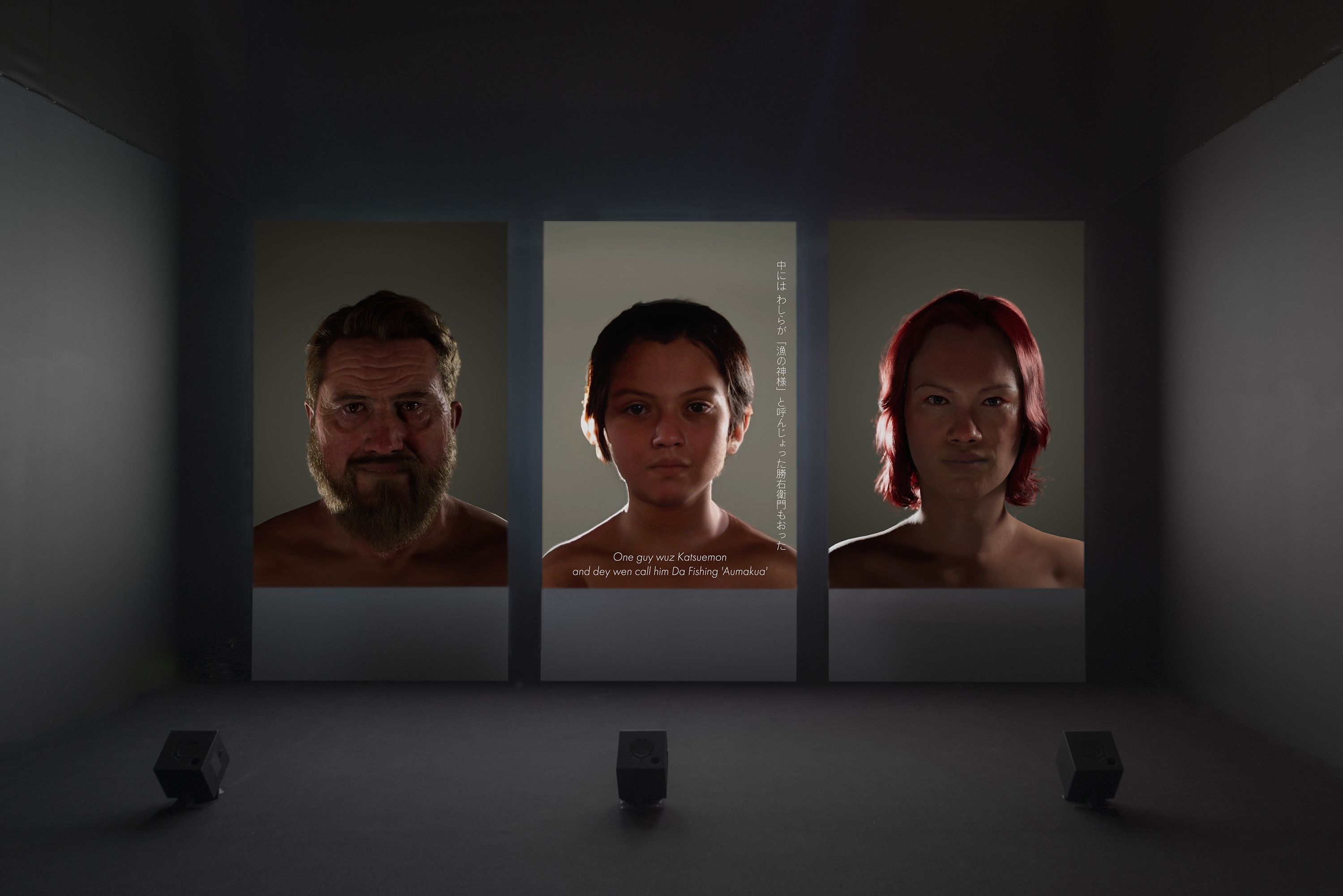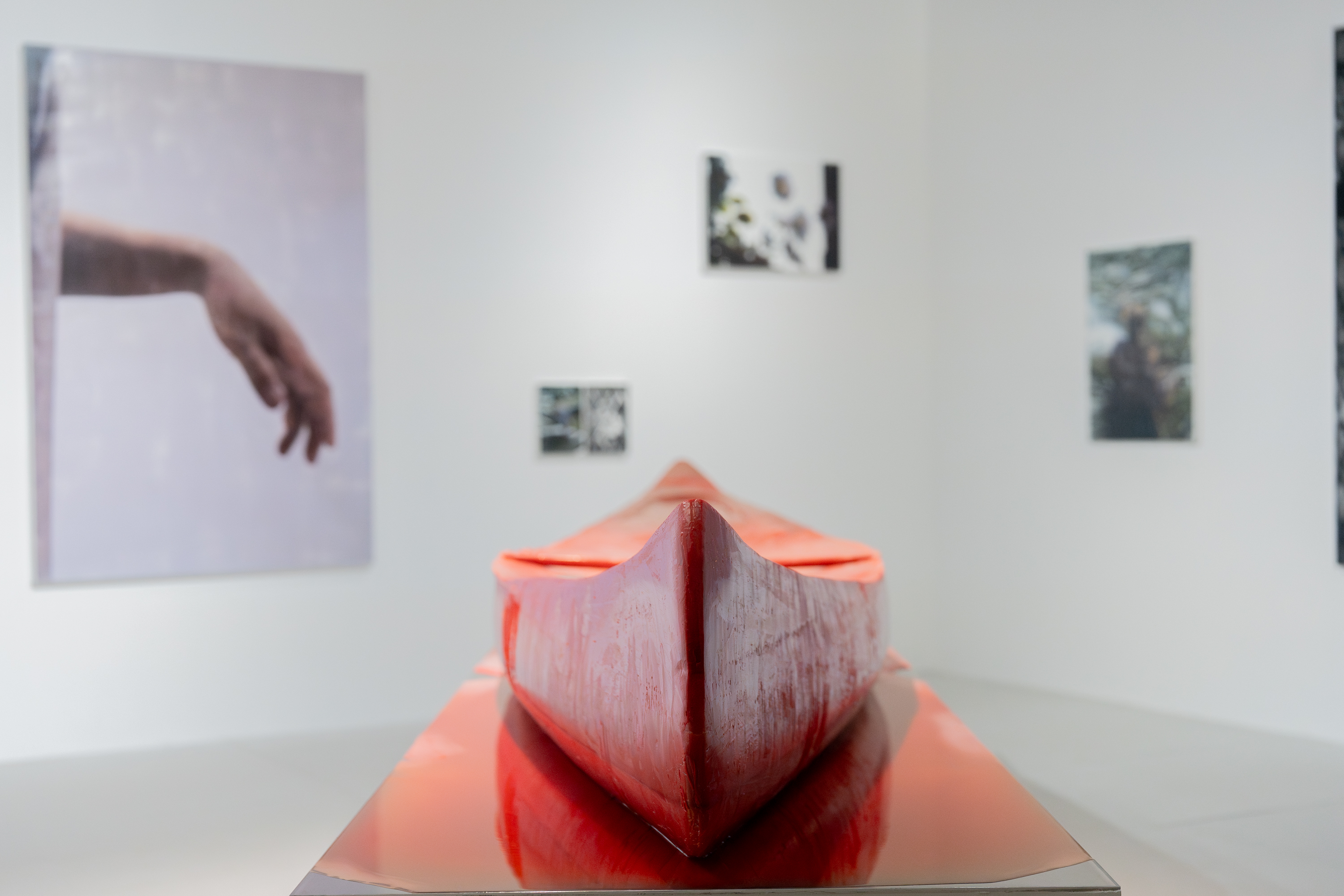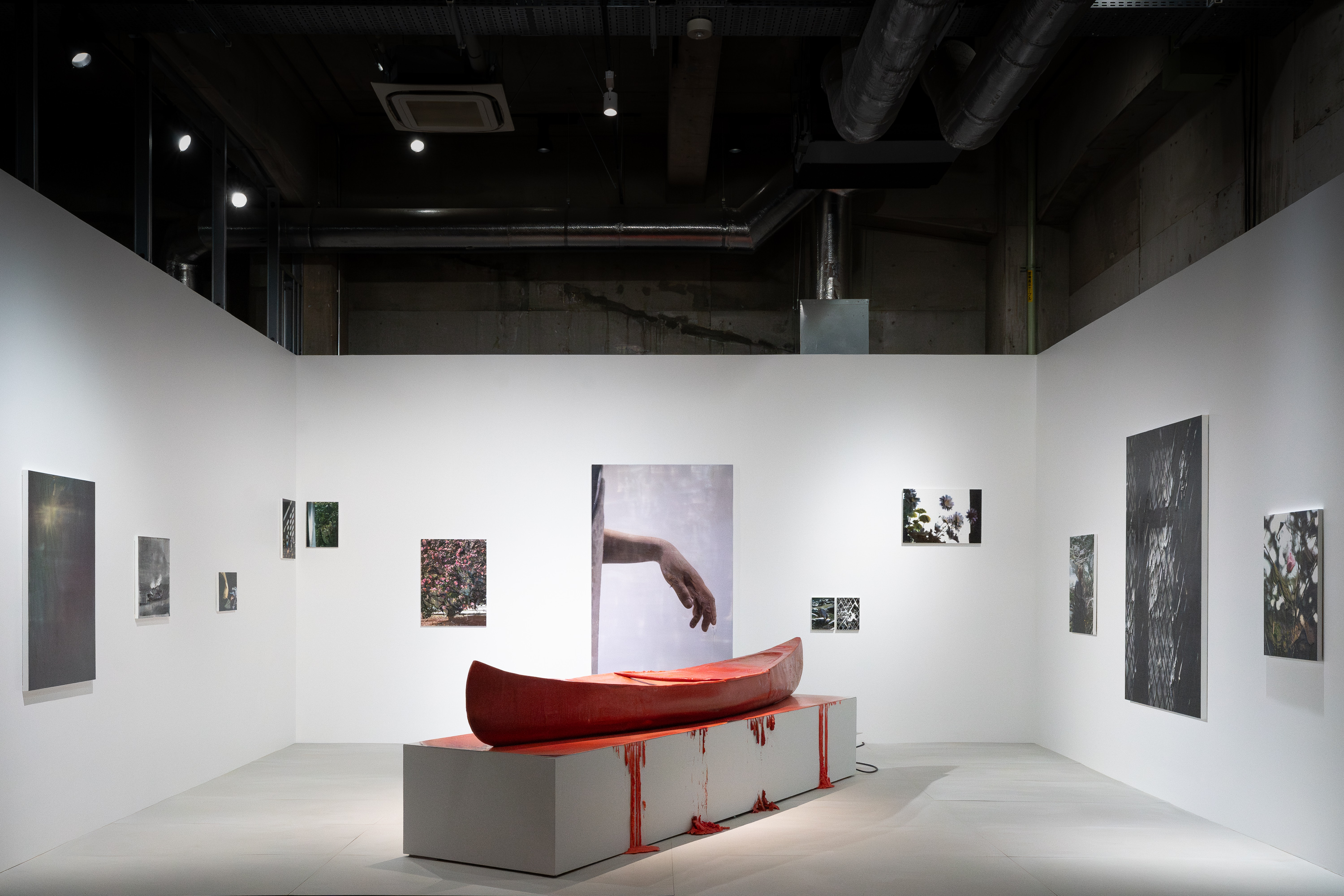“TERRADA ART AWARD 2023 Finalist Exhibition” Opens at Warehouse TERRADA: New Works by Mitsuo Kim, Yuma Tomiyasu, Yuki Harada, Satoshi Murakami and yang02
“TERRADA ART AWARD 2023” Award Ceremony From left: Mitsuo Kim, Yuma Tomiyasu, Yuki Harada, Satoshi Murakami and yang02
Unique warehouse company award
The contemporary art award TERRADA ART AWARD is designed to support emerging artists. Every two years, the jury carefully reviews the artists’ work and exhibition proposals before selecting the finalists. Over 1000 artists applied for the award last year, and five finalists were selected on September 11, 2023, approximately ten months after the application process started.
While there are plenty of public art competitions and awards, the TERRADA ART AWARD is unique to its founder, Warehouse TERRADA. There is no “Grand Prix” or ranking among the selected artists, but instead, a Jury Award is given to each finalist. Each jury member selects one artist and gives them feedback on their work, advice, and a message expressing their expectations for the future.

The five finalists are also awarded a cash prize of 3 million yen each and the opportunity to exhibit their work at the Finalist Exhibition before the announcement of the Jury Award. The final exhibition takes place in a warehouse space (Warehouse TERRADA G3-6F) that has been used in the past by internationally acclaimed artists. The five finalists are given approximately three months to create works based on their proposals and, with a production budget and a large exhibition space provided, are encouraged to explore original ideas and attract a diverse audience to see their creations.
Additionally, the finalists receive ¥100,000 worth of products from PIGMENT TOKYO, an art materials lab operated by Warehouse TERRADA, and complimentary use of the company’s art storage service for two years. By assisting with the purchase of art materials and the storage of artworks, Warehouse TERRADA aims not only to announce the winners but also to support the subsequent activities of the finalists in the long term.
TERRADA ART AWARD 2023 Finalist Exhibition opened on January 10, 2024, at the Warehouse TERRADA G3-6F and is scheduled to run until January 28.
Let’s look at the works and comments of the five finalists - Mitsuo Kim, Yuma Tomiyasu, Yuki Harada, Satoshi Murakami, and yang02 - along with the comments from the final jury.

Takahiro Kaneshima Award: Yuma Tomiyasu
“It is an extremely peculiar and unstable space. I hope you stay and experience it for four or five minutes.”
The Takahiro Kaneshima Award goes to Yuma Tomiyasu, known for her immersive installations based on personal interest in spiritual phenomena, psychic powers, and other non-scientific concepts that evoke a sense of the invisible and uncertain in the viewer. This time, Tomiyasu presents The Shift (2024), an installation work comprised of paintings, sound, light, and structures based on the theme of the inorganic nature of the warehouse. She commented on her work, “Recently, I have developed an interest in ‘dimensional shift’ and ‘dimensional layers.’ Since paintings share a strong affinity with ‘dimension,’ I have included several in this installation.”


Although the work is a 4:10-minute loop, the jury Takahiro Kaneshima (Associate professor of Kanazawa College of Art) hopes viewers will stay in the room for at least four or five minutes. He added, “The work incorporates a ‘shift’ in perspective into the act of viewing the work, skillfully combining two-dimensional paintings that carefully depict space and materials that divide space. The work was created in an inorganic warehouse, a difficult environment for creating site-specific works. Yet, it not only challenges the act of viewing the work and the viewer’s perspective, it also makes you rethink the nature of the work itself.”

Yukie Kamiya Award: Yuki Harada
“It is a challenging new way of combining portraits, storytelling, and subtitles through technology.”
Yukie Kamiya (Art critic, independent curator) has selected Yuki Harada, whose works are based on the motif of visual culture, which is widely recognized in society despite its insignificance. In this exhibition, Harada presents Shadowing (Three self-portraits) (2024), a work that focuses on transnational cultural motifs represented by ‘Pidgin English,’ a mixture of English and immigrant languages.
Harada expressed his gratitude for the award and the people involved, saying, “I was able to realize my vision because of the various environments provided for me.” He continued, “In Hawaii, I discovered my roots in the process of trying to depict ‘our story.’ I feel a sense of coming back to myself, and I am proud to say that I was able to create a ‘new self-portrait’ that reflects our contemporary spirit. I realize that I am now in a position to fulfill a dream plan that is only possible for a limited number of people, and I feel the responsibility. I am aware that I create self-portraits from a privileged position and intend to do my best in the future with even more responsibility.”

Kamiya added, “Harada weaves together complex and multi-layered elements that transcend time and space, connecting individual existence and society, others and oneself, by layering portraits, narratives, and subtitles on a single screen via digital technology. I want to encourage him to take on new challenges, too.”

Yuki Terase Award: yang02
“This cynical piece expresses the sadness and absurdity of art.”
Yang02, known for installations incorporating modern technology and information systems, combining and constructing them in ways that redirect and misuse them, presents a new piece, Great Emptiness (2024). This 30-minute “mechanical theatre” is only performed at 17:00 on weekdays and at 15:00 and 17:00 on Saturdays and Sundays. Outside these times, the theater is covered with blue tarps, preventing the audience from seeing all or even part of it. Therefore, it is recommended that you visit the venue during the performance hours if possible.

The work, which features the machine drawing on the wall and the Segway portraying the viewer drifting through the space and engaging in comic conversation, won the Yuki Terase Award. Accepting the award, yang02 commented, “Initially, I thought that it would be fun to have Ms. Terase, who is in the middle of the market, review my work since it was a proposal that approached the context of the art system, especially museums, warehouses, and the art market. Therefore, I am very grateful to receive this jury award, and I believe that it will inspire my future activities as an artist.”

Jury member Yuki Terase (Art Intelligence Global Founding Partner) noted, “This cynical piece expresses the sadness and absurdity of art: art swallowed up by capitalism, art being consumed, and art not being admired but stored in a warehouse. Of all the jury members, I am the one most involved with the art market, and I hope this award will inspire further exploration and even better pieces in the future.”
Daito Manabe Award: Satoshi Murakami
“This work offers new perspectives and discoveries, encouraging us to rediscover the beauty and issues of everyday life.”
The Daito Manabe Award went to Satoshi Murakami, who is known for creating works that place himself in public spaces, including living in a self-made Styrofoam house and a billboard using advertising income. In this exhibition, Murakami presents Those who talk about revolution (2024), inspired by the artist’s dream.

Murakami says that one day, he had a dream in which the stage prop “bush” spoke to him. “At the same time I had the dream, my grandfather, who suffers from dementia, came into my brother’s room to find the exit and mistook a coat hanger in the hallway for a human being. When giving form to these experiences as an artwork, I had an epiphany that I might also be able to consider the issue of “outline” in drawing at the same time. I want to thank my grandfather for this indirect help, the people who supported the project, and the TERRADA ART AWARD for helping me to realize my idea.”

Daito Manabe (Founder of Rhizomatiks, artist, interaction designer, programmer, and DJ) commented, “Murakami’s work offers new perspectives and discoveries, encouraging us to rediscover the beauty and issues of everyday life. When I first saw the proposal, I was eager to see the work come to life, even though it seemed difficult to put into words. The piece is an hour and a half long, but I hope you’ll see it in its entirety.”

Meruro Washida Award: Mitsuo Kim
“It is a tactile work of art. It carries the sense of connecting separated things.”
Mitsuo Kim, who uses paraffin wax in his two-dimensional and three-dimensional works, received the Meruro Washida Award. In this exhibition, he shows several works made from wax, including Good bye My Love (2023), an installation of a red wax canoe slowly melting on a metal table with a heat source. The melting wax is reminiscent of lava or blood, and the raw nature of the work leaves a strong impression on the viewer.

Kim commented, “Since last year, I have seen a lot of news about the war in Ukraine. Seeing images of fathers going to war and their wives and children fleeing the country reminded me of the stories of my mother and grandparents. It took me a long time to talk about my identity through my work, but now that I have received this award, I think I can be confident in expressing how I connect with this world. I will do my best while overlaying myself with the fluidity of wax.”

Meruro Washida (Director of Towada Art Center, Associate professor of Tokyo University of the Arts) noted, “The canoe references Kim’s identity positioned between Korea and Japan and symbolizes the ‘in-between.’ Unlike previous works in which the actual canoe was filled with wax, this time, the canoe itself is made of it, and the entire structure will melt and change shape over the exhibition period. This will bring out the canoe’s fragility and increase the work’s intensity. This is one of the reasons why I have high expectations for this new piece.”

Warehouse TERRADA and artist support
Warehouse TERRADA in the Tennoz area attracts many art lovers as an exciting art district throughout the year. The company has a long history of engaging with art and has been one of the industry’s most experienced art and artifact storage operators since it launched the service in the 1970s. In recent years, it has also opened several art-related facilities, including WHAT MUSEUM and TERRADA ART COMPLEX.
In July 2023, Warehouse TERRADA became an official fair partner of the international art fair Tokyo Gendai and organized the TENNOZ ART WEEK. The event was bustling with art collectors and art lovers from all over the world. Transforming from a warehouse district to an art district, Warehouse TERRADA is committed to developing Tennoz into the world’s most exciting art capital.
Among these activities, the company is particularly focused on supporting artists. In addition to the award, Warehouse TERRADA also offers artists support for production and exhibitions. For example, the renovated warehouse space, TAC ART STUDIO, offers seventeen studios and shared spaces with high ceilings that can be used for large-scale three-dimensional works. The art materials lab, PIGMENT TOKYO, also provides a place for artists to work and share their expertise.
In addition, WHAT CAFE opened in 2020 as a facility to exhibit and sell contemporary art by emerging artists. The 800m² space allows many up-and-coming artists to show their works to a diverse audience. A special award-related exhibition is also on view until January 16, 2024.
Warehouse TERRADA commented on this year’s award, “We hope that the finalists of the TERRADA ART AWARD will surpass the existing standards of the Japanese art scene and spread their wings to the world. We will continue to support the careers of internationally acclaimed artists after receiving the award.”
Supporting artists is essential to the growth of the art industry and the evolution of Tennoz as the world’s most exciting art capital. Artists will continue to gather in Tennoz to innovate the contemporary art scene. We hope you will experience the start of this new era at the TERRADA ART AWARD Finalists Exhibition.

Chiaki Noji
Chiaki Noji



